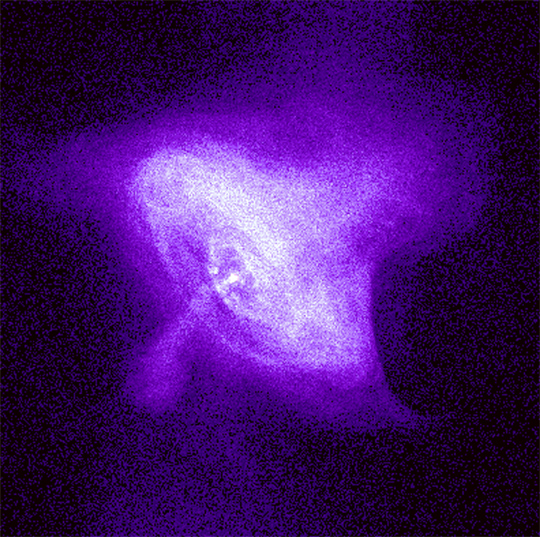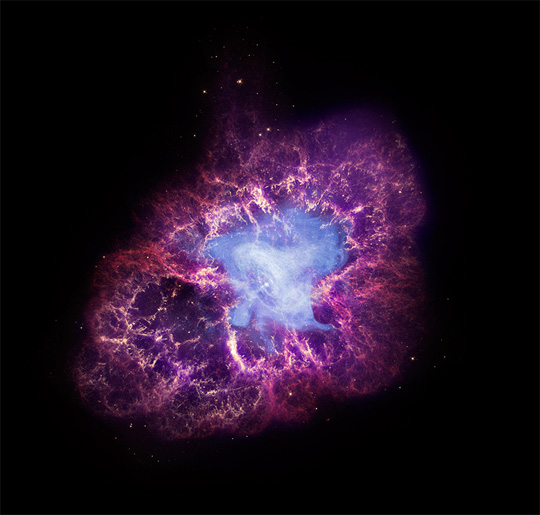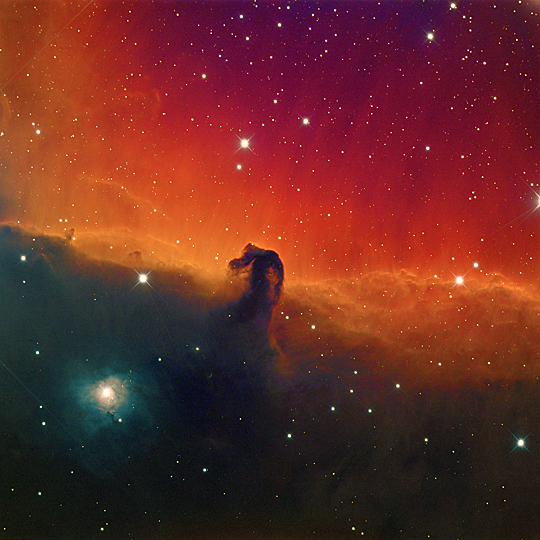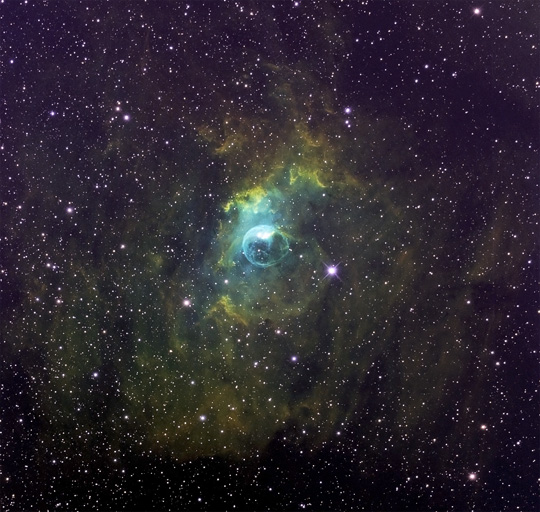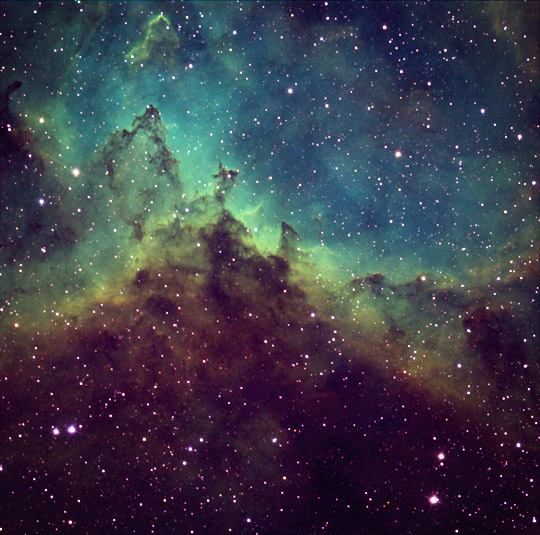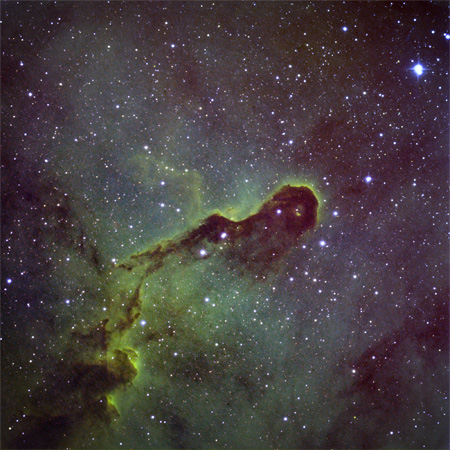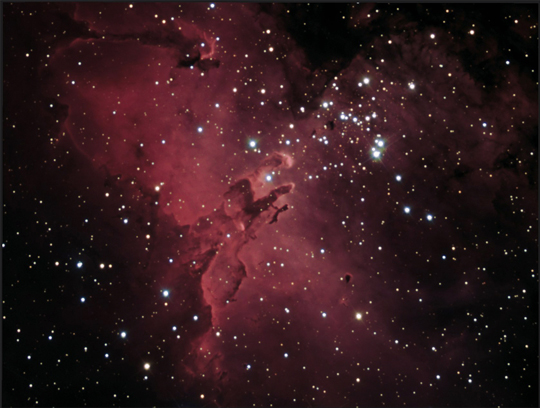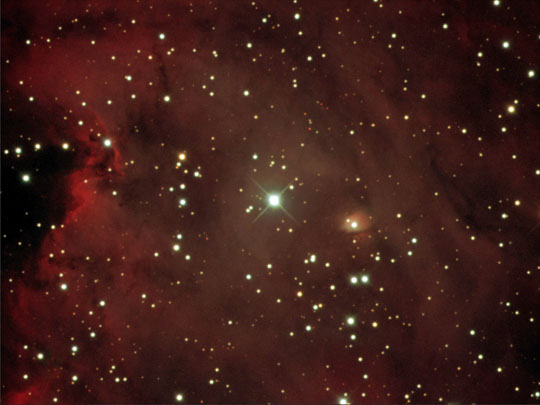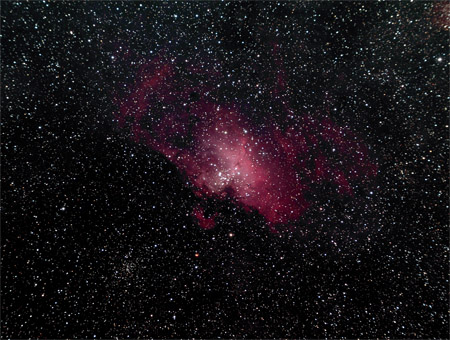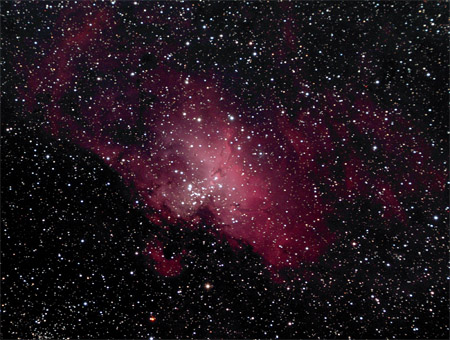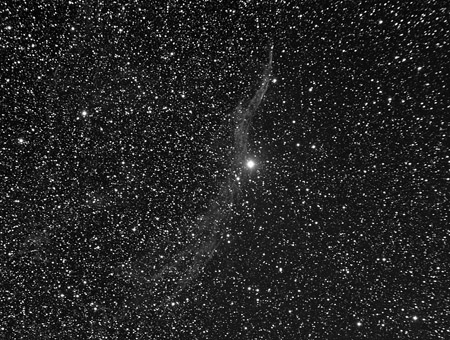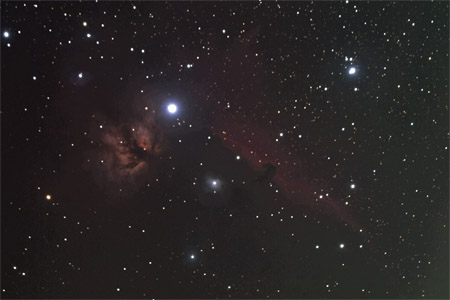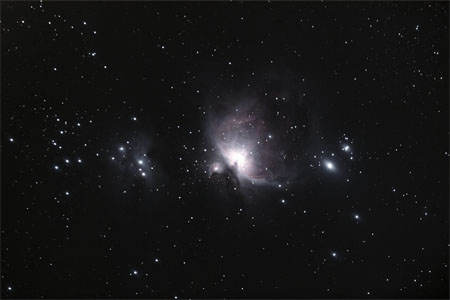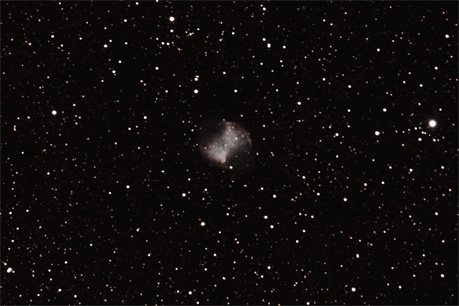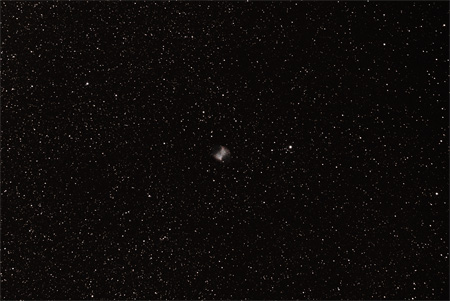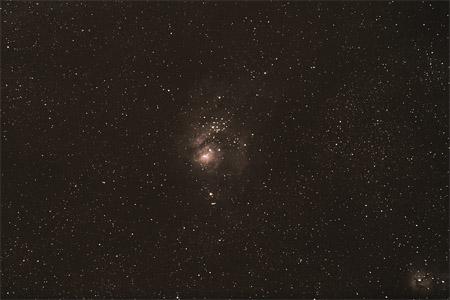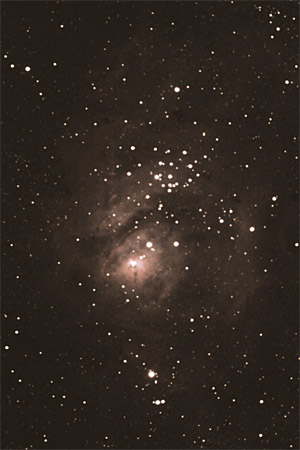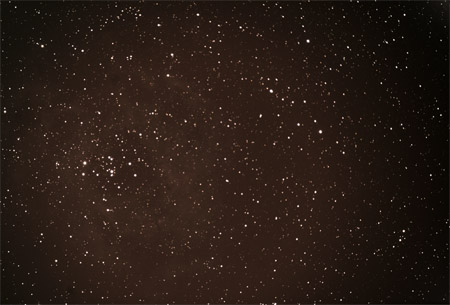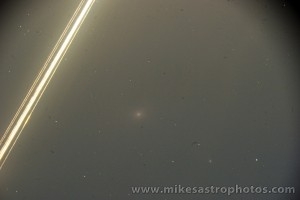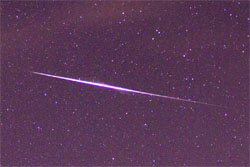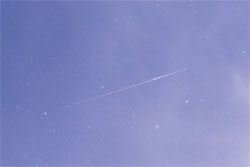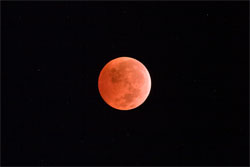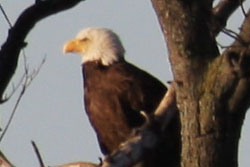Nebula
Messier 1 – The Crab Nebula
by Mike Hankey, under Nebula
The Crab Nebula is a great example of what a star looks like soon after it has run out of fuel, collapsed on itself and blown up in a super nova explosion — one of the largest and most violent releases of energy the Universe has to offer. Long before Charles Messier cataloged it, the ancient Chinese witnessed the super nova that created The Crab Nebula as it erupted, recording the phenomenon in their history books and detailing its location, brightness and longevity. The exploding star was so bright it could even be seen during the daytime.
Below is my first photo of the new year, Messier #1 — The Crab Nebula. It looks more like a sea sponge or luffa to me, but this object got its name from an early observer who described the fuzzy ball as looking like a crab. The image below is a long exposure photograph taken from my ground based observatory in the Sierra Nevada Mountains. It’s a combination of 2 hours of Red, Green and Blue PLUS 7.4 hours of Luminance (clear) and 8.6 hours of Ha for a total exposure time of : 2 + 2 + 2 + 7.4 + 8.6 = 22 hours! To spice things up a little bit more, I added a layer of X-Ray data captured by one of NASA’s space based telescopes, The Chandra X-Ray Observatory. Note: the diagonal line on the bottom right of the Nebula is not a satellite but actually a refraction spike from a bright star nearby but off frame.
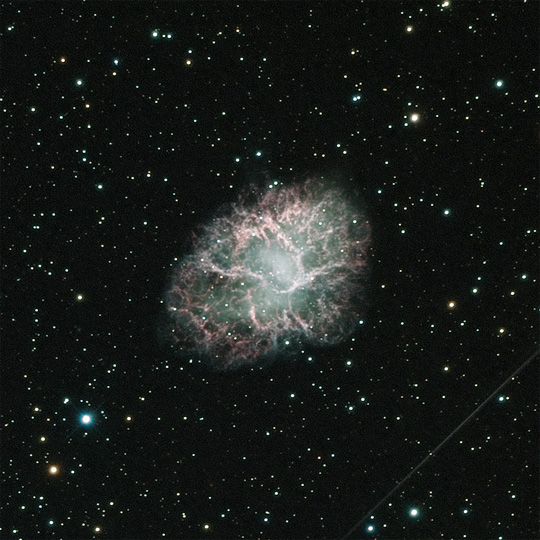
The Crab Nebula – With Chandra X-Ray Data – January 4th, 2014 – Credit Mike Hankey & NASA Chandra X-Ray Observatory
The Chandra X-Ray data reveals a neutron star in the center of the Crab Nebula that was hypothesized and later discovered in the 1960s. Below is an x-ray image of the Crab Nebula taken by NASA’s Chandra X-ray Observatory. I blended this X-ray photo as a layer with my final LRGB-Ha image.
You might be wondering how I knew where to put the X-Ray data or where it is inside my picture. I was subtle about blending it in, but to give you an idea of where the x-ray data is relative to the visual light data, take a look at this image of the Crab Nebula published by NASA using data collected from Hubble, Chandra and Spitzer space telescopes. (This was the guide I used to place the Chandra data on my picture).
Visit this link, if you are wondering what my Crab Nebula Image looks like without the x-ray data, or check out this animated gif showing my image of the Crab Nebula with and without the x-ray data.
As a final thought, The Crab Nebula is approximately 4,000 light years away, so if the Chinese saw it explode 1000 years ago, how many years ago did it actually blow up? This is a little bit of a joke, but I actually thought about that for a second and it got me wondering about how long the Crab Nebula has looked this exact way, and I wonder how it must have looked just a few days after the super nova went off. As it turns out, the gases in this nebula are still expanding and photos taken over a series of years actually show the clouds growing. Especially the x-ray images! Watch this movie showing changes in the Crab Nebula’s clouds over just six months or check out the Crab Nebula photos inside the Chandra X-Ray Image Archive to see how things have changed over the years.
Image Details for Messier 1 – The Crab Nebula
Narrow Band Ha – 8.6 hours
RGB: 2 hours each
Luminance: 7.4 hours
Total exposure: 8.6 + 7.4 + 2 + 2 + 2 = 22 hours!
Camera: Apogee U16M
Guider: SBIG 402 with MMOAG Off Axis Guider
Telescope: RCOS 14.5
Mount: Paramount ME
Location: Auberry, CA
Date: Over 6 nights in December
Software: The SkyX, MaximDL, FocusMax, CCDAutoPilot, CCDStack, Photoshop
Horse Head Nebula
by Mike Hankey, under Nebula
When I first started learning about astronomy, there were three deep space objects that really captivated my attention: The Andromeda Galaxy, The Orion Nebula and the Horse Head Nebula. As time passes and I come back to these targets I appreciate things about them I never knew or noticed before. After getting involved with horses this year I started thinking about the Horse Head Nebula again and wanting to image it. Its not visible in the summer, but this past November, as soon as the conditions and time were right, I started working on it. I just finished up last week. Over 38 hours of exposure time through 7 different channels on more than 20 different nights contributed to this final picture below. Its a combination of light data collected through narrow band (Ha, Oii & Siii), RGB (Red, Green & Blue) and Luminance (clear) filters.
Image Details for The Horse Head Nebula
Narrow Band Ha, Oii, Siii: 7.6 hours each
RGB: 3 hours each
Luminance: 6 hours
Total exposure: 7.6 + 7.6 + 7.6 + 3 + 3 + 3 + 6 = 37.8 hours!
Camera: Apogee U16M
Guider: SBIG 402 with MMOAG Off Axis Guider
Telescope: RCOS 14.5
Mount: Paramount ME
Location: Auberry, CA
Date: Over 20 nights from November through December
Software: The SkyX, MaximDL, FocusMax, CCDAutoPilot, CCDStack, Photoshop
Bubble Nebula
by Mike Hankey, under Nebula
I haven’t gotten much scope time in this year for several reasons, some technical, some personal and most related to the short nights of summer. Now that the dark hours are longer and I’ve worked through a lot of my issues, I’m getting back into it. Here’s my first long exposure image since March. Its the NGC 7635, an emission nebula hidden in the constellation Cassiopeia. This image was shot using narrow band filters over 4 nights. A total of 15 hours of exposure time went into this picture.
Photo Details
M51
Shot With Narrow Band Filters 5 hours Each: Ha, Oii, Si
Total exposure: 15 hours
Camera: Apogee U16M
Guider: SBIG 402 with MMOAG Off Axis Guider
Telescope: RCOS 14.5
Mount: Paramount ME
Location: Auberry, CA
Date: September 24th – September 28th 2013
Software: The SkyX, MaximDL, FocusMax, CCDAutoPilot, CCDStack, Photoshop
Heart Nebula – IC 1805
by Mike Hankey, under Nebula
Here’s part of the Heart Nebula, an emission nebula found in the constellation Cassiopeia. This expansive mixture of glowing interstellar gas and dust is over 200 light years wide and covers 2.5 degrees in the night sky — that’s a cloud of dust that would appear 5 times the size of the moon! Too bad we can’t see it with our naked eye, but turn a telescope with narrow band filters on it for a few hours and this is what you get. Click the pictures below for a high res version 1800×1750 pixels big.
In order to capture the entire nebula with my current telescope I’d need make a mosaic using 6-8 pictures like the one above.
Photo Details
The Heart Nebula – IC 1805
Ha, Oiii, Sii @ 120x120x120 Minutes Each – Hubble Palette
Total exposure: 6 hours
Camera: Apogee U16M
Guider: SBIG 402 with MMOAG Off Axis Guider
Telescope: RCOS 14.5
Mount: Paramount ME
Location: Auberry, CA
Date: 1/1/2012, 1/2/2013
Software: The SkyX, MaximDL, FocusMax, CCDAutoPilot, CCDStack, Photoshop
Elephant Trunk Nebula in Hubble Palette
by Mike Hankey, under Nebula
Here’s my first ever narrow band image using the Hubble pallet. This is only about a 3 hour exposure. I wanted to collect more data, but a multi-day storm has come through CA and there won’t be a clear night for about a week, so I figured I would get this done as best I could and consider it version 1. Here is a great tutorial on how to compose Hubble Palette images using data collected with Ha, Oii & Siii narrow band filters. I’ve gotten most of the bugs out of my system, but my tracking is still not 100%. I’m currently dealing with a 2 arc second guide error peak to peak, and I’d like to get that down to 1 arc second. Other than that, things are working pretty good.
Approximately 3,000 light years away, the Elephant Trunk Nebula is part of the emission nebula IC 1396. It was given this name as the gas cloud resembles the head and trunk of an elephant. While the entire nebula covers 5 degrees of the night sky, the trunk part of it is estimated to be 20 light years long.
Photo Details
NGC 891
Ha, Oiii, Sii @ 60x60x60 Minutes Each
Total exposure: 3 hours
Camera: Apogee U16M
Guider: SBIG 402 with MMOAG Off Axis Guider
Telescope: RCOS 14.5
Mount: Paramount ME
Location: Auberry, CA
Date: 11/27/2012, 11/28/2012
Software: The SkyX, MaximDL, FocusMax, CCDAutoPilot, CCDStack, Photoshop
Messier 16 – The Eagle Nebula
by Mike Hankey, under Nebula
Here’s a recent long exposure photo of the great Eagle Nebula.
There’s a lot more detail in this picture compared to this wide field shot of the Eagle Nebula I took about the same time last year. A years experience and a big optics upgrade can make quite a difference in magnification and photo quality.
This is the first image I’ve taken since March and the first serious chunk of time spent on my scope since then as well. I attribute the astro-hiatus to a combination of bad weather and the new Sutters Mill Meteorite fall. When I got back to the scope, I was feeling renewed and I wanted to tackle all of the tech problems I was having the last time around. I worked on this picture over a series of nights making corrections to the setup as I went along. I ended up throwing out multiple runs due to poor quality, but in the process was able fix quite a few glitches in my system. Over this period I
- re-placed and re-setup my PC in order to fix a nasty crashing issue, upgrading from windows XP to a newer box and win7 in the process
- re-installed/reconfigured all astronomy software
- re-collimated primary mirror
- fixed a sticking secondary focuser (hopefully for good)
- tweaked the polar alignment
- worked out all of the kinks in CCDAP except for one
So the last problem that plagues me is recovering a CCDAP session after the meridian flip. Once I figure that out, I will have completed my training with CCDAP and should be able to execute automated astrophotography runs while I am sleeping, which is an amazing feat and something I’ve been looking forward to for quite some time. It will have taken me nearly a year to setup, learn to use, tweak and refine this hardware and software to get it to the point that it is working perfectly. In less than 1-2 months I will need to tear it all down, ship it across the country and set it all up again in a remote observatory in California. Fortunately, the setup the second time around won’t be as hard.
Photo Details
Messier 16 – The Eagle Nebula
RRGB 80X80X60X60 Minutes Each
Total exposure 3 hours 20 minutes
Camera: SBIG ST8300
Guider: SBIG 402 with MMOAG Off Axis Guider
Telescope: RCOS 14.5
Mount: Paramount ME
Location: Freeland MD
Date: 6/25, 6/26
Software: The SkyX, CCDSoft, FocusMax, CCDAutoPilot, CCDStack, Photoshop
NGC 2175
by Mike Hankey, under Nebula
Here’s a recent astrophoto of NGC 2175, an open cluster centered in the Monkey Head Nebula. Found in target rich Orion, this nebula is a huge cloud of hydrogen gas covering an area larger than the full moon. The star cluster is visible to the aided eye and was first discovered before 1654 by Giovanni Batista Hodierna.
Click the picture above for a larger image, or download this huge full resolution desktop wall paper version.
Eagle Nebula
by Mike Hankey, under Nebula
Here’s a photo of the Eagle Nebula I took back in July. The nebula also referred to as the pillars of creation is a about 6500 light years away from Earth and the column of star forming gas and dust in the center is approximately 60 trillion miles high. At least we know there are somethings in the universe bigger than our national debt.
Here’s a higher zoom picture of the center area.
Primarily visible during the summer months, the Eagle Nebula is one of the most majestic and awe inspiring objects in the night sky.
NGC 6960
by Mike Hankey, under Nebula
Here’s an astrophoto of NGC 6960 from a couple of weeks ago. Also known as the Veil Nebula, NGC6960 is a cloud of heated and ionized gas and dust found in the constellation Cygnus.
This is the second in a series of test photos that I took during the last new moon phase at the beginning of June. I was testing and improving various aspects of the system. Most of the photos shot during this period were black and white mainly because I was working on other issues at the time, like: tracking/polar alignment, guiding, focusing/image correction, flat/dark calibration and learning new software and techniques. It was a very productive week.
The photo does suffer from a few problems including: imperfect guiding and distorted optics, especially at the corners of the image. This seems to be one of my last major hurdles and requires getting the field flattener set just right. Part of the process of improving the pictures is identifying specific imperfections, understanding why they exist and then acting to formulate solutions to the challenges. Despite these problems, I’m still happy with the image especially since its only the second photo I’ve taken with this new camera system.
Photo Details
5×10 Clear Filter / Total Exposure Time 50 minutes
Camera SBIG ST8300
Guiding with 402 & Piggy back guide scope
Paramount ME Mount
William Optics FLT98
CCDSoft / The Sky X / CCDStack
The Horse Head Nebula
by Mike Hankey, under Nebula
The Horsehead Nebula is found on the left side of Orion’s Belt, near the star Alnitak. It is difficult to see with the naked eye through a telescope, but on a long exposure it can be a remarkable sight.
Photo Details:
William Optics FLT 98 / CGEM Mount
Canon 20Da Camera
SBIG STV Autoguider
20×5 minute ISO 400 exposures
Deep Sky Stacker
Photoshop cleanup
M42 – The Great Orion Nebula
by Mike Hankey, under Nebula
Its that time of year again and Orion the hunter is currently rising in the east just before midnight. Orion is home to several spectacular nebula the most famous being M42 – The Great Orion Nebula. M42 is a defuse nebula situated just below Orion’s belt. Coming in at 24 light years across and only 1,344 light years away from Earth, the great nebula is big enough and bright enough to see with the naked eye, but without optics, its not much more than a smudge located in the center star of Orion’s sword. This diffuse nebula is one of the brightest nebula in the sky and a fantastic sight in binoculars or a small telescope. Here’s a recent picture of the nebula, much better than my first.
Photo Details:
William Optics FLT 98 / CGEM Mount
Canon 20Da Camera
SBIG STV Autoguider
12×3 minute ISO 400 exposures
Deep Sky Stacker
Photoshop cleanup
M27 – Dumbell Nebula
by Mike Hankey, under Nebula
Here’s a picture of the Messier 27, the Dumbell Nebula, a planetary nebula 1367 light years away from Earth.
Full magnification cropped frame below.
and here is the full picture.
Photo Details
William Options FLT 98
Canon 20Da Camera
60×1 minute ISO 400
SBIG STV Auto Guider
Lagoon Nebula – M8
by Mike Hankey, under Nebula
Here’s a photo of Messier 8 — The Lagoon Nebula, a giant interstellar cloud in the constellation Sagittarius.
Rosette Nebula
by Mike Hankey, under Nebula
Here’s a picture of NGC 2244 I took using the new telescope. I’m really still figuring things out with this new scope, trying to get it setup, get polar alignment right, get focusing right — basically re-learn everything I’ve learned in the last year with the other scope. I was able to capture this photo on the third night of using the new scope.
Photo Details
Optics: Willamoptics FLT 98
Camera: Canon 20da
Exposure: Multiple 18×3 minute exposures, flats, darks
Software Processing: Deep Sky Stacker, Photoshop Elements
NGC 2244
by Mike Hankey, under Nebula
Here is a photo of NGC 2244 an open cluster within the Rosetta Nebula discovered by John Flamsteed in 1690. The Rosetta Nebula is a giant molecular cloud and the stars inside this cluster were formed from the nebula’s matter. You can see bits of the nebula cloud in the picture below.
